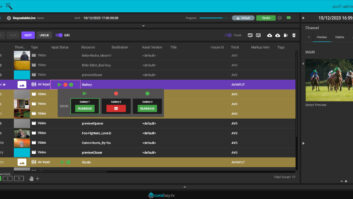
Replacing aging SDI-based infrastructures with IP-based infrastructure technology has become an increasingly popular choice among broadcasters seeking to improve workflow efficiency and cut costs.
Hasan Kiragi (pictured), director of broadcast operations at Dogan TV Holding, talked about his company’s successful transition from an SDI to IP workflow.
Why did you decide that you need to migrate from SDI to IP?
HK: Towards the end of 2007, we started the D-Smart pay-TV satellite platform project as a new business within Dogan TV Holding. The D-Smart Platform planned to have movie and drama channels as well as live sports, music channels, and some retransmit channels. The total number of channels planned to be on-air was more than 40 to start with.
As was the standard way of implementing a TV infrastructure, we first prepared a technical project based on HD-SDI technology with lots of SDI distribution, signal processing equipment, very large SDI routers, and SDI multiviewers. As usual, the system design based on SDI was bulky, inflexible, costly, and not easy to operate or maintain. At that point, based on our four years of IT-based broadcast experience for file based workflows with Cinegy solutions, we realized that it was possible to move broadcast quality live video operations to IP.
So we contacted Cinegy and discussed the possibility of such a development and shared with them the basic modules and functionality of the IP- based live broadcast solution we had in mind. After some discussion, it was decided that the project was feasible and affordable. We then began the development of IP-based live workflow as an extension to, and an integral part of, the existing Cinegy solution.
How long did it take from decision to implementation? What challenges have you met?
HK: We started using some modules of the system in the middle of 2009. It took two to three years to have the whole solution ready as a live video broadcast system. The basic source, destination, and routing workflow of live SDI video is not that different with a live IP infrastructure, but the biggest difference was that we did not have a baseband video anymore that we could physically hold and patch, which was unusual, but a welcome change for our video technicians and engineers.
Could you please define the possible steps of transition from SDI to IP operations?
HK: Firstly, you have to get your signals on an IP domain. If you have a studio connected to the external world, its outputs should be sent on an IP domain and IP signals should be received on a SDI domain. To achieve this, you need to replace your old equipment with new devices that are capable of live IP streaming (DVB compliant) or you need to use gateways converting the SDI signal to IP and vice versa.
The next step is just implementation. All you need is to choose appropriate network switchers and build a reliable broadcast- capable network. Depending on the project complexity you may have some extra reasons for building a robust broadcast operation. In Dogan, we have two multicast networks working in parallel, so each source to our system simultaneously pushes IP streams in both networks in each destination.
The Cinegy Multiviewer, Ingest and Playout machines are connected to both networks and simultaneously get the multicast streams. If you have deployed an IP network, you don’t have an SDI signal anymore and you can’t patch it from some point to another point by just connecting BNC cables. If something goes wrong in the network you are stymied. That’s why we implemented parallel network switches from different brands. If one brand fails we failover to the other one.
Could you tell us a bit more about the problems that Cinegy solves for you?
HK: No dependency on any proprietary hardware and format technology; freedom to use any standard IT equipment; and a flexible and scalable system design are what we essentially benefit from with Cinegy’s file-based video and IP solutions.
Regarding cost and operational management, have you noticed an improvement?
HK: For daily live broadcast operations there was no big difference. The improvements were on technical layouts that give us the potential for cost effective and flexible design. For example, we do not have to worry about live signals, neither as an input port number nor output port number for the routing; nor do we have to lay down thousands of meters of video cables to carry the live signals. We can carry hundreds of live video signal on a single 10gbps network port. In what way did the process of migration from SDI to IP influence the people working at Dogan?
HK: At the operational level, there were no big differences for video technicians and engineers, they just learnt how to set up and operate the related software. which was a straightforward and easy process for those familiar with a software-based IT approach. For others it took a little more time, but even then the learning curve was short because the software is so intuitive.
Because our broadcast chain now relies on IT systems, we reorganized our technical department to reflect those changes. Prior to the change, we had broadcast engineers with just enough knowledge of IT systems, and IT engineers with just enough knowledge of broadcast systems and workflows. Now, with the help of Cinegy, we have a technical department that is very conversant in both worlds. Our transition from SD to HD was transparent, again due to Cinegy, and our move from cassette to tapeless, and SDI to IP, were also easy because our technical people knew how to make the transition as a group.
Could you please provide an overview of your Cinegy system?
HK: All of our workflows (except for studio production) – recording, editing, archiving, playout, live signaling, graphics and insertion, and offline editing of the news program – are all based on Cinegy and IP-technologies.
We have 440 concurrent users of Cinegy Desktops and about 800 users in total. We have a five Petabyte archive and 260 TB of storage for production purposes. All important materials are also copied and transferred to our Ankara Disaster site. 25 ingest stations enable us to work with live records, IP streams and the remains of SDI signals. There are about 100 playout servers (redundant playout included) in our master control rooms for our major (Kanal D, CNN Türk) and satellite channels. On the production site we have about 30 studio playout servers for our 11 studio production locations. 50 IP multicast gateways convert SDI signals to IP and IP to SDI.
We also have Cinegy IP-tools to manage, monitor, and control all IP- streams in our workflow.
How many networks do you have? Do you use separate networks for video streaming?
HK: We have three separate networks that are completely isolated and all have full redundancy. One of them is used for file-based video operations and our office network.
Another two networks that work in active/active operation are dedicated to live broadcast video operations and for failsafe operation.
Could you tell us about the disaster recovery systems in the new building?
HK: We have a scaled down Cinegy system in our Ankara location. We keep all of our file-based archive copies as a disaster backup and have limited playout and uplink functionality there as well.
How do Dogan News Agency (DHA) and D Productions use the new IP-environment?
HK: Live video operations, including news feeds from SNG trucks of DHA, monitoring of satellite video feeds and DHA news playout satellite feed completely runs on a live IP environment. D Productions utilize the live IP site to simultaneously record from multiple cameras (up to eight) from the same production studio.
Do you have any remaining SDI equipment or infrastructure? Do you use tape anywhere in your system?
HK: We still have SDI operations in our studio productions (SDI based cameras, studio vision mixers, studio graphic equipment, etc.) and some of our satellite encoders have SDI input. But even for that equipment and those locations, live signal routing is performed through Cinegy Live IP networks and the signal is converted to SDI via IP-SDI gateways at the last point that it is needed. We don’t use any tape in Dogan TV center. We only have some HDCAM tape machines in case some HDCAM tapes arrive in our center from third parties.
Do you use 4K material in Dogan?
HK: Not yet. We have plans to use it for OTT services soon. I suppose that would be 4K music clips from third parties. We have just started testing this technology.
What about cloud technologies? Do you use it?
HK: We already have a lot of virtualization installations. Some of the Cinegy services already run in virtual environments and we are already testing and augmenting the Cinegy Air operations on virtual servers.
For example, we sell our content to the third parties, so we have to prepare the formats of those videos depending on the request.
We use Cinegy Convert running on the virtual services for it. We also have some services for 24/7 recording and ingesting of some TV channels, news feeds, and at least a couple of channels running simultaneously on a single server with virtualization in test mode. And we have GPU virtualization in this scenario also.
What are your plans for the future and Cinegy?
HK: We have a very innovative and productive partnership with Cinegy, now for more than 12 years. I expect, being a leading IT-based broadcast technology R&D company, that Cinegy will continue to cover more areas of broadcast technology and continue to improve existing products.







